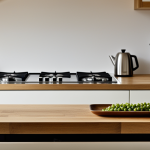Essential techniques for crispy Yorkshire pudding
Achieving a crispy Yorkshire pudding hinges on mastering a few critical factors. First, the Yorkshire pudding recipe must have the right batter consistency. The batter should be smooth, with a pourable thickness similar to single cream. This consistency ensures it spreads easily in the pan and creates the signature rise and crisp edges.
Temperature plays a pivotal role. Both the oven and fat temperatures must be extremely hot before adding the batter. The fat should shimmer and just start to smoke in the pan; if it’s too cool, the pudding won’t crisp properly. Preheating the oven to at least 220°C (425°F) is essential to generate the rapid steam burst needed for a perfect rise and crispiness.
Also read : How can you recreate the rich taste of a classic steak and ale pie?
Selecting the right pan and fat type also influences results. Use a heavy-based, heat-retentive pan, such as a cast-iron tray or non-stick muffin tin, that evenly distributes heat. For fat, traditional beef dripping gives excellent flavour and crisp texture, but vegetable oils with a high smoke point, like sunflower or grapeseed oil, can also work well. The fat must cover the base thinly but thoroughly to encourage even cooking.
By carefully balancing these elements—batter consistency, heat control, and pan choice—you can consistently create a crispy Yorkshire pudding that rises beautifully and delivers the satisfying crunch everyone expects.
Additional reading : What are the steps to making a comforting chicken tikka masala?
Step-by-step method for best results
Achieving the perfect Yorkshire pudding relies heavily on the precise Yorkshire pudding step by step process. Start with preparing the batter by mixing flour, eggs, and milk until smooth and then letting it rest. Resting the batter for at least 30 minutes allows the gluten to relax and the mixture to thicken slightly, improving texture and rise during baking.
Next, heat your chosen pan until it’s extremely hot before adding the fat. The fat must be smoking hot to create that initial sizzle, which traps steam and encourages the essential puffiness and crispy Yorkshire pudding edges. Only pour the rested batter into the hot fat; doing this too early can result in a soggy base and poor rise.
During baking, keep the oven door closed to maintain high heat and steam within. Bake at 220°C (425°F) or higher for about 20–25 minutes, depending on your oven. This intense heat helps the batter rise rapidly and form a crunchy exterior. Following these baking tips step by step maximizes the chance of producing a Yorkshire pudding that is both fluffy inside and delightfully crisp outside.
Understanding the science behind crispiness
The science of Yorkshire pudding revolves around achieving the ideal balance between steam, heat, and batter structure to create that sought-after crispy Yorkshire pudding texture. When the batter hits the hot fat, water in the mixture rapidly turns to steam. This steam inflates the batter, causing it to rise quickly and form a delicate, airy interior while the exposed edges crisp up beautifully.
Gluten formation is another vital factor in this batter chemistry. As the flour, eggs, and milk combine, gluten strands develop, providing the pudding with structure and elasticity. Resting the batter allows these gluten networks to stabilize, which supports a consistent rise without collapsing. However, over-mixing can strengthen gluten too much, making the pudding tough, so a balance is essential.
Fat selection also plays a critical role in crispiness. The science of Yorkshire pudding shows that fats with a high smoke point—such as beef dripping or certain vegetable oils—can be heated to very high temperatures without burning. This heat generates the initial sizzle that locks in moisture and creates a crispy base. The choice and temperature of the fat thereby directly influence how well the pudding crisps during baking.
Mastering these scientific principles ensures you achieve the perfect Yorkshire pudding—light and fluffy inside with a satisfyingly crisp exterior, thanks to controlled steam generation, precise gluten development, and the right fat heated to the correct temperature.
Avoiding common Yorkshire pudding mistakes
Achieving a crispy Yorkshire pudding involves avoiding frequent Yorkshire pudding mistakes that can undermine your success. One common error is over-mixing the batter, which strengthens gluten excessively, resulting in a dense, chewy pudding rather than a light and airy one. To prevent this, mix just until smooth and let the batter rest, allowing gluten to relax and improve texture.
Another frequent baking error is opening the oven door too soon. This sudden temperature drop releases steam, causing the puddings to deflate and lose their characteristic crisp edges. Maintaining a stable, high oven temperature throughout baking ensures the batter rises properly and maintains its crunch.
Incorrect pan or fat choice also affects outcomes. Using a pan that is too large or too small can disrupt heat distribution, leading to uneven cooking. Similarly, low smoke point fats will break down and burn, creating off-flavors and compromising crispiness. Selecting a heavy-based pan and a fat like beef dripping or high smoke point oil guarantees consistent heat and the signature golden, crispy Yorkshire pudding base.
By steering clear of these pitfalls—over-mixing, premature oven door opening, and wrong pan or fat selection—you maximize your chances of baking the perfect Yorkshire pudding with the ideal rise and crunch.
Advanced tips and chef secrets
Discovering advanced Yorkshire pudding tips can elevate your baking from good to professional. One key technique involves batch prepping your batter and puddings. Preparing the batter in advance and allowing it to rest overnight in the fridge intensifies flavor and improves the texture, leading to a perfect Yorkshire pudding with enhanced rise and crispiness. Once cooked, letting Yorkshire puddings cool on a wire rack prevents steam accumulation, which otherwise softens their delicate crust.
Reheating for maintained crispiness is another chef secret. Instead of microwaving, which often results in soggy puddings, reheat them in a hot oven at around 180°C (350°F) for 5–10 minutes. This quick heat refreshes the crisp edges and warms the interior evenly, producing a satisfying texture akin to freshly baked puddings.
Professional bakers also emphasize the importance of consistent oven temperature throughout cooking and reheating. Fluctuations can cause uneven rising or sogginess. Using a heavy-based tray and high smoke point fats ensures stable heat transfer and contributes to that golden, crispy exterior prized in professional Yorkshire pudding preparations.
Mastering these chef advice tips offers a practical path to reliably baking Yorkshire puddings with outstanding texture and flavour every time.
Essential techniques for crispy Yorkshire pudding
Achieving a crispy Yorkshire pudding starts with gauging the ideal batter consistency. The batter should be smooth and slightly thick, similar to single cream, as this consistency ensures it spreads evenly in the Yorkshire pudding recipe. If the batter is too thin, the puddings risk becoming flat and soggy, while an overly thick batter can prevent a good rise and result in a dense texture.
Equally crucial is maintaining high oven and fat temperatures. The oven must be preheated to at least 220°C (425°F) to generate the intense heat necessary for steam to rapidly expand the batter. The fat, typically beef dripping or a high smoke point oil, should be smoking hot before pouring in the batter. This heat causes the batter’s water content to instantly vaporize, creating steam that puffs the pudding while crisping the edges to perfection.
Selecting the right pan and fat type has a significant effect on outcomes. A heavy-based pan, such as cast iron or a sturdy non-stick tin, retains and distributes heat evenly, preventing uneven cooking. Regarding fat, traditional beef dripping imparts superior flavor and crispness, but vegetable oils like sunflower or grapeseed can also create a perfect Yorkshire pudding base due to their high smoke points. The fat layer must be thin yet cover the entire base to encourage consistent crisping during baking.
These core techniques—balanced batter consistency, intense heat, and appropriate pan and fat choices—are essential baking tips to achieve that hallmark rise and crunch of a memorable Yorkshire pudding.






